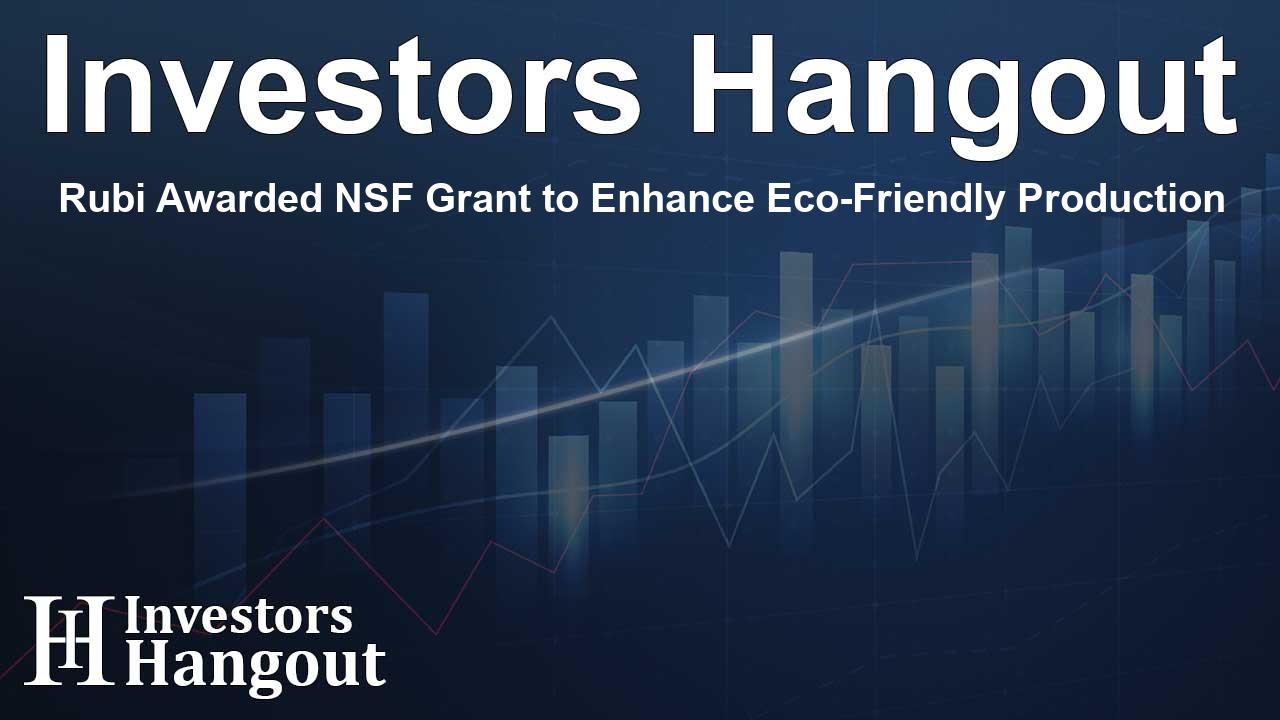Rubi Awarded NSF Grant to Enhance Eco-Friendly Production

Rubi Secures $1 Million Phase II Grant from the National Science Foundation
A significant milestone for Rubi, the company has been awarded a $969,961 Phase II grant from the National Science Foundation (NSF), enabling it to further develop its pioneering carbon-to-cellulose technology. This esteemed grant, awarded to less than 5% of applicants, underscores Rubi's innovative approach to redefining materials manufacturing and its ambitious goal of a sustainable future.
Transforming CO2 into Valuable Materials
Rubi leads the charge in pioneering a unique cell-free biocatalysis technology designed to convert carbon dioxide into essential materials. With an immediate focus on producing CO2-derived cellulose, Rubi aims to replace conventional wood pulp in textile manufacturing. This endeavor is crucial not only for combating climate change but also for significantly diminishing the detrimental effects of traditional raw material production.
Funding as a Catalyst for Growth
The recent grant from the NSF serves as a catalyst for Rubi's growth, driving the company's mission to supply low-carbon materials to meet global demands. With a strong operational foundation, Rubi has established itself as a leading player in creating more sustainable industrial processes.
Innovations and Strategic Partnerships
Building upon the success of its Phase I grant, Rubi achieved numerous milestones in recent years. The company secured an impressive $8.7 million seed funding round co-led by prominent brands, fostering vital partnerships with top fashion brands like H&M, Patagonia, and Reformation.
Pioneering Collaborations
Furthermore, Rubi has initiated several pilot projects in collaboration with major retailers such as Walmart. This reflects a growing industry recognition of Rubi's transformative technology in converting CO2 into usable products. In remarkable strides, Rubi successfully debuted the world’s first completely enzymatic yarn made from CO2 with the fashion label Ganni.
A Vision for the Future
Neeka Mashouf, Co-Founder and CEO of Rubi, commented, "This NSF award is a significant validation of our vision for a future where manufacturing operates in harmony with the environment. Our goal for 2025 is to drastically scale the production of CO2-derived cellulose for the textile industry, allowing us to redefine how materials are sourced and produced."
The NSF's Role in Advancing Innovations
Supporting startups that are on the cutting edge of technology, the NSF plays a vital role in the development of innovative solutions that address pressing environmental issues. Erwin Gianchandani, NSF Assistant Director for Technology, remarked on the significance of the funding, stating, "Supporting companies like Rubi is pivotal for translating groundbreaking scientific discoveries into sustainable practices that can reshape industries."
Rubi's Groundbreaking Technology
Rubi's innovative biomanufacturing platform utilizes specialized enzymes to convert simple carbon molecules into cellulose efficiently. In contrast to traditional fermentation methods, which can be resource-intensive and produce substantial waste, Rubi’s approach is designed to minimize costs and maximize yield, revolutionizing the manufacturing landscape.
Efficiency and Sustainability Combined
Dr. Leila Mashouf, Co-Founder and CTO of Rubi, explained, "By eliminating the exploitation of natural resources, our technology offers a sustainable and efficient method for producing carbon-derived materials. We aim to produce cellulose rapidly while significantly lowering emissions and resource strain traditionally associated with wood pulp production."
About Rubi
Founded by twin sisters Neeka and Dr. Leila Mashouf, Rubi is revolutionizing the manufacturing sector with its game-changing technology that converts waste carbon into critical materials. With a focus on environmental sustainability, the company embodies a new approach to production that aligns industrial growth with ecological mindfulness.
Frequently Asked Questions
What is Rubi's main technology?
Rubi specializes in a cell-free biocatalysis technology that converts CO2 into cellulose and other materials.
How much funding did Rubi receive from NSF?
Rubi secured a grant of $969,961 from the National Science Foundation for their Phase II project.
What are Rubi's primary partnerships?
Rubi has partnered with major brands including H&M, Patagonia, and Reformation for sustainable textile production.
What is the significance of the NSF grant for Rubi?
The grant supports Rubi’s mission to advance sustainable manufacturing and promote low-carbon materials in the industry.
What are Rubi's future goals?
Rubi aims to accelerate the production of low-carbon cellulose to transform the textile industry by 2025.
About The Author
Contact Ryan Hughes privately here. Or send an email with ATTN: Ryan Hughes as the subject to contact@investorshangout.com.
About Investors Hangout
Investors Hangout is a leading online stock forum for financial discussion and learning, offering a wide range of free tools and resources. It draws in traders of all levels, who exchange market knowledge, investigate trading tactics, and keep an eye on industry developments in real time. Featuring financial articles, stock message boards, quotes, charts, company profiles, and live news updates. Through cooperative learning and a wealth of informational resources, it helps users from novices creating their first portfolios to experts honing their techniques. Join Investors Hangout today: https://investorshangout.com/
The content of this article is based on factual, publicly available information and does not represent legal, financial, or investment advice. Investors Hangout does not offer financial advice, and the author is not a licensed financial advisor. Consult a qualified advisor before making any financial or investment decisions based on this article. This article should not be considered advice to purchase, sell, or hold any securities or other investments. If any of the material provided here is inaccurate, please contact us for corrections.
